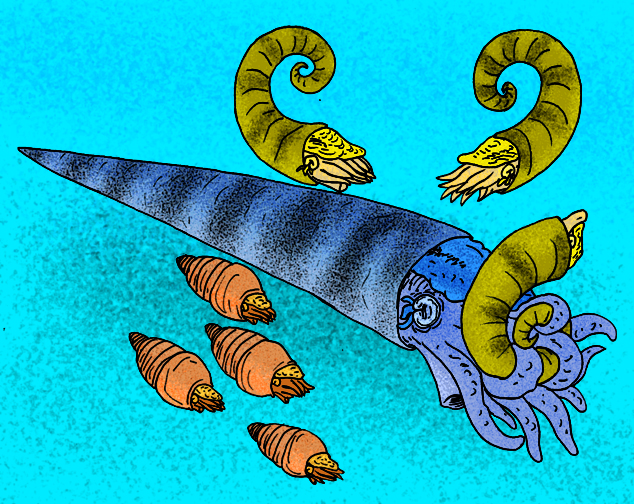- Cameroceras
image_caption = "Cameroceras trentonese"
fossil_range =Ordovician
regnum =Animal ia
phylum =Mollusc a
classis =Cephalopod a
subclassis =Nautiloid ea
ordo =Endocerida
familia =Endoceratoidea
genus = "Cameroceras"
genus_authority = Conrad, 1842
subdivision_ranks = Species
subdivision =
* "C. alternatum"
* "C. hennepini"
* "C. inopinatum"
* "C. stillwaterense"
* "C. trentonese""Cameroceras" ("chambered horn") was a genus of giant
orthocone cephalopod that lived in theOrdovician period.The partial shell of one giant "Cameroceras" yielded a total length estimated at the time at nearly 30 feet (9 m). (This estimate has since been revised downward quite a bit.cite journal|author=Teichert C and B Kummel|year= 1960|title=Size of Endocerid Cephalopods|journal=Breviora Mus. Comp. Zool.|volume=128|pages=1-7] ) Regardless of this estimate's degree of accuracy, this gargantuan cephalopod was one of the largest animals ever to live during the Paleozoic Era, if not the largest. Judging from its huge size, it was likely an
apex predator that lived in deeper water (it would possibly have been unable to maneuver in shallow water), and probably fed oneurypterid s such as "Megalograptus ", large trilobites, and smaller cephalopods. The program "Chased by Sea Monsters" speculatively suggests that it was largely blind, having large, yet feeble eyes like those of what may be its closest living relative, "Nautilus ".Taxonomic usage
"Cameroceras" has become a catch all term, or "
wastebasket taxon ," for any large orthoconic endocerid such as "Endoceras", "Vaginoceras", "Meniscoceras", and even "Cameroceras" as a described genus. Although "Cameroceras trentonense" was first described by Conrad for the species in 1842 since then the generic term has had variable meaning. Hall, who named and described "Endoceras" in 1847 recognized "Cameroceras trentonense" specifically but used "Endoceras" for other species of large endocerids from the Trenton Limestone of western New York state."Cameroceras" and "Endoceras" may even apply to different stages of the same species. Although "Cameroceras" takes precedence where the two refer to the same species, its vague application leaves "Endoceras" or other well described genus the term of choice.
In popular culture
It was featured in the Ordovician section of the
BBC series "Sea Monsters " (a spin-off to the successful "Walking with Dinosaurs ") as the top predator, and also had a brief cameo in "Walking with Monsters ", bobbing in the water. In theWalking with Dinosaurs companion books, it is misspelled as "Cameraceras".ee also
*
Cephalopod size Notes and references
*Flower, Rousseau H. 1955. Status of Endoceroid Classification. "Journal of Paleontology" 29: 329–371.
*Haines, Tim, & Chambers, Paul. 2005. "The Complete Guide to Prehistoric Life." BBC Books, London.
*Sweet, Walter C. Cephalopoda--General Features in "Treatise on Invertebrate Paleontology, Part K, Mollusca 3". Geological Society of America, and University of Kansas Press. Page K5.
*Teichert, C. 1964. Endoceratoidea in "Treatise on Invertebrate Paleontology, Part K, Mollusca 3". Geological Society of America, and University of Kansas Press. Page K174.
*Teichert, C., and B. Kummel 1960, Size of Endocerid Cephalopods; Breviora Mus. Comp. Zool. No. 128, 1–7.
Wikimedia Foundation. 2010.

